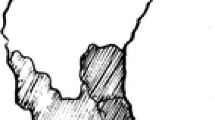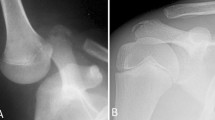Abstract
Aim
A limitation of movement is considered as a postoperative effect of open shoulder stabilization. The stabilization method by Warren was identified in clinical examinations and cadaver testing as a particularly well adapted treatment to avoid postoperative movement limitations. The results after open shoulder stabilization by the method of Warren including possible differences between patients suffering from posttraumatic or habitual recurrent luxations were recorded and prognostic criteria for every group were established.
Method
During the period between January 1, 1996 and December 31, 2000, 81 patients suffering from anterior shoulder instability were operated using the Warren method. The examinations were performed before and on average 46.4 months after the operation (minimum 12 months; maximum 7 years). General data of the patients included active and passive mobility, scores according to Rowe, Kohn and Constant, redislocation, complications and further treatment.
Results
62 patients were suffering from a posttraumatic recurrent luxation, 16 patients had a habitual recurrent luxation and 3 patients were treated for a voluntary luxation. Patients who were younger than 30 years showed a higher number of preoperative dislocations. They had a higher risk of postoperative redislocation and showed more often a habitual component. All scores increased significantly: the Rowe score from 34 to 79, the Kohn score from 74 to 87, the Constant score from 82 to 89 points. Patients with a posttraumatic recurrent luxation obtained better scores and better postoperative mobility. Before operation, the mobilities of the affected shoulders were reduced in all levels of movement in comparison to the other side. After operation a deterioration of the passive mobility in any direction was not registered. Adduction, anteflexion and external rotation with the arm abducted 90° improved significantly. However the abduction, retroflexion, internal and external rotation with the arm at the side, as well as for the internal rotation with the arm abducted 90° were unchanged. The active mobility for abduction and anteflexion improved significantly after operation and achieved the values of the other side. After operation, eight patients sustained another redislocation. Five of these patients had already been operated on previously, three sustained a real (adequate) trauma. Only one of the patients (1.6 %) suffered from a real redislocation, caused by a light (bagatelle) trauma. In the final examination, we registered positive tests for instability for 18 % of the patients with a habitual recurrent dislocation.
Conclusion
Open shoulder stabilization by the method of Warren does not cause postoperative persistent movement limitations. Limitations exist already before the operation and were a result of the disease itself. The Rowe, Kohn and Constant scores improved significantly. Pa tients suffering from a posttraumatic recurrent luxation obtained better results than patients suffering from a habitual recurrent luxation. The rate of redislocation at 1.6 % is very low.
Zusammenfassung
Studienziel
Als Folge offener Schulterstabilisierungen wird allgemein eine postoperative Bewegungseinschränkung angenommen. Die Stabilisierung nach Warren konnte als besonders gut geeignetes Verfahren im Kadavertest und bei klinischen Untersuchungen identifiziert werden, um postoperative Bewegungsdefizite zu vermeiden. Die Ergebnisse nach offener Schulterstabilisierung mittels der Methode nach Warren sollen analysiert werden, Unterschiede zwischen Patienten mit posttraumatisch und habituell rezidivierenden Luxationen erfasst und prognostische Kriterien für die einzelnen Gruppen erstellt werden.
Methode
Im Zeitraum vom 1.1.1996 bis zum 31.12.2000 wurden 81 Patienten wegen einer ventralen Instabilität des Schultergelenkes mittels der o.g. Methode operiert. Die Untersuchung wurde präoperativ und durchschnittlich 46,4 Monate nach der Operation mit einem Minimum von 12 Monaten und einem Maximum von 7 Jahren durchgeführt. Wir erfassten allgemeine Patientendaten, aktive und passive Beweglichkeiten, die Scores nach Rowe, Kohn und Constant, Rezidive, Komplikationen und Nachbehandlungsregime.
Ergebnisse
62 Patienten litten an einer posttraumatisch rezidivierenden, 16 Patienten an einer habituell rezidivierenden und 3 Patienten an einer willkürlichen Instabilität. 86,4 % der Patienten konnten nachuntersucht werden. Patienten unter dem 30. Lebensjahr wiesen eine höhere Zahl präoperativer Luxationen, ein höheres Risiko für postoperative Rezidivluxation und häufiger eine habituelle Komponente auf. In allen Scores stiegen die Werte signifikant an: der Rowe-Score von 34 auf 79, der Kohn- Score von 74 auf 87 und der Constant- Score von 82 auf 89 Punkte. Patienten mit posttraumatisch rezidivierender Luxation erreichten bessere Werte in den Scores und der postoperativen Beweglichkeit. Präoperativ war die Beweglichkeit der erkrankten Schulter in allen Gruppen in allen Bewegungsebenen im Vergleich zur Gegenseite vermindert. Postoperativ war in keiner Bewegungsrichtung eine Verschlechterung der passiven Beweglichkeit festzustellen. Die Adduktion, die Anteflexion und die Außenrotation bei 90° abgespreiztem Arm verbesserten sich signifikant, Abduktion, Retroflexion, Außen- und Innenrotation bei angelegtem Arm und die Innenrotation bei 90° abgespreiztem Arm bleiben unverändert. Die aktive Beweglichkeit verbesserte sich signifikant und erreichte die Werte der Gegenseite. Postoperativ trat bei 8 Patienten eine erneute Luxation auf. 5 dieser Patienten waren bereits voroperiert, 3 Patienten erlitten ein echtes adäquates Trauma. Nur bei 1 Patienten (1,6 %) kam es zu einem echten Rezidiv anlässlich eines Bagatelltraumas (keine Voroperation). Zur Nachuntersuchung stellten wir bei 18 % der Patienten mit einer habituell rezidivierenden Luxation positive Instabilitätstests fest.
Schlussfolgerung
Die offene Schulterstabilisierung nach Warren führt zu keiner postoperativ persistierenden Bewegungseinschränkung, sondern diese ist auf die Erkrankung selbst zurückzuführen und bereits präoperativ vorhanden. In den Scores nach Rowe, Kohn und Constant ist eine signifikante Verbesserung nachweisbar. Patienten mit einer posttraumatisch rezidivierenden Luxation erreichen bessere Ergebnisse als Patienten mit habituell rezidivierenden Luxationen. Die Rezidivrate ist mit 1,6 % als sehr niedrig einzustufen.
Similar content being viewed by others
Literatur
Altchek DW, Warren RF, Skyhar MJ, Ortiz G (1991) T-Plasty Modification of the Bankart Procedure for Multidirectional Instability of the Anterior and Inferior Types. J Bone Joint Surg, 73-A(1):105.
Andary JL, Petersen SA (2002) The Vascular Anatomy of the Glenohumeral Capsule and Ligaments: An Anatomic Study. J Bone Joint Surg, 84-A(12):2258–2264.
Bankart ASB (1923) Recurrent or Habitual Dislocation of the Shoulder-Joint. British Med J, 2:1132–1133.
Bauer T, Wehrle J-P,Schuler P (1999) Die offene Bankart-Operation mit Mitek-Ankern zur Behandlung der vorderen Schulterinstabilität. Orthopädische Praxis, 35(2):79–84.
Birkner, Henchem (2002) Die Bedeutung der extrakapsulären Technik bei der arthroskopischen Schulterstabilisierung mit Suretac. Orthopädische Praxis, 38(6):381–384.
Bohnsack M, Rühmann O, Börner C, Schmolke S, Wirth CJ (2003) Die arthroskopische anteriore Schulterstabilisierung durch Kombination von laserassistiertem Kapsel-Shrinkage und Nahttechnik im Vergleich mit anderen Operationsverfahren. Sportverletzung Sportschaden, 17(1):26–31.
Calvo E, Granizo JJ, Fernandez-Yruegas D (2005) Criteria for arthroscopic treatment of anterior instability of the shoulder: a prospective study. J Bone Joint Surg Br, 87(5B):677–683.
Fabbriciani C, Milano G, Demontis A, Fadda S, Ziranu F, Mulas PD (2004) Arthroscopic Versus Open Treatment of Bankart Lesion of the Shoulder: A Prospective Randomized Study. Arthroscopy: The Journal of Arthroscopic and Related Surgery, 20(5):456–462.
Freedman KB, Smith AP, Romeo AA, Cole BJ, Bach BR Jr (2004) Open Bankart repair versus arthroscopic repair with transglenoid sutures or bioabsorbable tacks for recurrent anterior instability of the Shoulder – a meta analysis. Am J Sports Med, 32(6):1520–527.
Fremerey R, Bosch U (2001) Chronische Instabilitäten und veraltete Luxationen der Schulter. Zbl Chirurgie, 126:184–191.
Geiger DF, Hurley JA, Tovey JA, Rao JP (1997) Results of Arthroscopic Versus Open Bankart Suture Repair. Clin Orthop, 337:111–117.
Gohlke F, Essigkrug B, Schmitz F (1994) The pattern of the collagen fiber bundels of the capsule of the glenohumeral joint. J Shoulder Elbow Surg, 3(A):111–128.
Gohlke F, Jansen E (2002) Instabilität des Glenohumeralgelenks. In: Gohlke F, Hedtmann A, Hrsg. Schulter – das Standardwerk für Klinik und Praxis. Stuttgart, New York: Thieme, 379–448.
Habermeyer P, Lichtenberg S (2003) Diagnostik und Therapie der vorderen und hinteren Schulterluxation Teil I: Diagnostik. Der Chirurg, 74(11):1078–1088.
Habermeyer P, Lichtenberg S (2003) Diagnostik und Therapie der vorderen und hinteren Schulterluxation Teil II: Therapie. Der Chirurg, 74(12):1178–1194.
Hale J, Rokito AS, Chu J (2005) Anterior Capsulolabral Reconstruction for Traumatic Recurrent Anterior Shoulder Dislocation. Bulletin Hospital for Joint Diseases, 62(3–4):94–98.
Imhoff AB, Schmid A (2001) Arthroskopische Schulterstabilisierung. Deutsche Gesellschaft für Chirurgie, Kongressband 118:349–351.
Jung D, Habermeyer P, Lehmann L (2000) Arthrofibrose bei arthroskopischer Stabilisierung der primären Schulterluxation. Arthroskopie, 13:237–340.
Kartus J, Ejerhed L, Funck E, Köhler K, Sernert N, Karlsson J (1998) Arthroscopic and open shoulder stabilization using absorbable implants: A clinical and radiographic comparison of two methods. Knee Surg, Sports Traumatol, Arthrosc, 6(3):181–188.
Kuhnert K (1997) Vergleich offener und arthroskopischer Operationstechniken bei posttraumatisch rezidivierenden, habituellen und willkürlichen Schultergelenksluxationen (Dissertation). Jena: Friedrich-Schiller-Universität.
Levine WN, Rieger K, McCluskey GM (2005) Arthroscopic Treatment of Anterior Shoulder Instability. Instructional course lectures, 54:87–96.
Lichtenberg S, Magosch P, Habermeyer P (2005) Traumatische vordere Schulterluxation. Unfallchirurg, 108(4):299–314.
Lichtenberg S, Magosch P, Habermeyer P (2005) Arthroskopische Stabilisierung bei der traumatischen vorderen Schulterluxation. Unfallchirurg, 108(4):315–318.
Marx RG, McCarty EC, Montemurno TD, Altchek DW, Craig EV, Warren RF (2002) Development of arthrosis following dislocation of the shoulder: A case-control study. J Shoulder Elbow Surg, 11:1–5.
Matsoukis J, Tabib W, Guiffault P, Mandelbaum A, Walch G, Nemoz C, Edwards TB (2003) Shoulder arthroplasty in patients with a prior anterior shoulder dislocation. Results of a multicenter study. J Bone Joint Surg, 85A(8):1417–1424.
Mazzocca AD, Brown FM JR, Carreira DS, Hayden J, Romeo AA (2005) Arthroscopic Anterior Shoulder Stabilization of Collision and Contact Athletes. A Jour Sports Med, 33(1):52–60.
Mishra DK, Fanton GS (2001) Two-Year Outcome of Arthroscopic Bankart Repair and Electrothermal-Assisted Capsulorrhaphy for Recurrent Traumatic Anterior Shoulder Instability. Arthroscopy, 17(8):844–849.
Nebelung W, Röpke M, Urbach D, Becker R (2001) A new technique of arthroscopic capsular shift in anterior shoulder instability. Arthroscopy, 17(4):426–29.
Pap G, Machner A, Merk H (1997) Die Behandlung der rezidivierenden traumatischen Schulterluxation mit der Coracoid-Transfer-Operation nach Laterjet-Bristow. Zbl Chirurgie, 122(5):321–326.
Pap G, Machner A, Heitmann H, Merk H, Neumann HW (2001) Reluxationen nach arthroskopischer Labrumrefixation mittels Fadenankern bei traumatischer ventraler Schulterluxation. Zbl Chirurgie, 126:199–204.
Perthes G (1906) Über Operationen bei habitueller Schulterluxation. Deutsche Zeitschrift für Chirurgie, 85:199–227.
Pötzl W, Witt KA, Hackenberg L, Marquardt B, Steinbeck J (2003) Results of suture anchor repair of anteroinferior shoulder instability: A prospective clinical study of 85 shoulders. J Shoulder Elbow Surg, 12(4):322–326
Refior HJ (2002) Schulterluxation, rezidivierend und habituell. In: Dt. Gesellschaft f. Orthopädie und orthopäd. Chirurgie + BV d. Ärzte f. Orthopädie, Hrsg. Leitlinien der Orthopädie. Zweite Aufl. Köln: Dt. Ärzte-Verlag
Resch H, Wanitschek P, Sperner G (1989) Die Technik der Bankart'schen Operation: Eine modifizierte Reinsertionstechnik. Unfallchirurg, 92(8):407–413.
Rosenberg BN, Richmond JC, Levine WN (1995) Long-term Followup of Bankart Reconstruction: Incidence of Late Degenerative Glenohumeral Arthrosis. Am J Sports Med, 23(5):538–544.
Rowe CR, Patel D, Southmayd WW (1978) The Bankart Procedure: A Long-Term End-Result Study. J Bone Joint Surg, 60A:1–16.
Ruppert R, Edlich M, Erggelet C (2003) Mittelfristige Ergebnisse der offenen Schulterstabilisierung nach Putti-Platt bei rezidivierender Schulterluxation. Orthopädische Praxis, 39(4):277–281.
Sperner G, Wambacher M, Golser F, Kralinger F, Smekal V (2000) Intra- und postoperative Komplikationen bei der arthroskopischen Labrum- und Kapselrefixation mit dem Suretacimplantat. Arthroskopie, 13:232–236.
Tingart M, Bäthis H, Bouillon B, Tiling T (2001) Die Therapie der traumatischen vorderen Schulterluxation: Aktueller Stand der Therapie in Deutschland. Chirurg, 72(6):677–683.
Tjoumakaris FP, Abboud JA, Hasan SA, Ramsey ML, Williams GR (2006) Arthroscopic and open Bankart repairs provide similar outcomes. Clin Orthop Rel Res, 446:227–232.
Wang C, Ghalambor N, Zarins B, Warner JJ (2005) Arthroscopic versus open Bankart repair: analysis of patient subjective outcome and cost. Arthroscopy, 21(12):1219–1222.
Warren RF (1985) Instability of shoulder in throwing sports. Instructional course lectures, 34:337–348.
Author information
Authors and Affiliations
Corresponding authors
Rights and permissions
About this article
Cite this article
Ziegert, I., Ziegert, A. & Irlenbusch, U. 4-Jahres-Ergebnisse nach Behandlung der vorderen Schulterinstabilität mittels der Kapsel-Labrum-Plastik nach Warren. Obere Extremität 3, 9–17 (2008). https://doi.org/10.1007/s11678-008-0072-7
Received:
Accepted:
Issue Date:
DOI: https://doi.org/10.1007/s11678-008-0072-7




